


THE WAR OF AMERICAN INDEPENDENCE 1775 -
THE DECLARATION OF INDEPENDENCE 4TH JULY 1776
xxxxxAs we have seen, the First Continental Congress was held in September 1774, following the harsh measures imposed after the so called Boston Tea Party of 1773. It appealed to George III for fairer treatment, but the petition was rejected. The Second Congress, summoned in May 1775, took a stronger stand following the Battles of Lexington and Concorde. An army was raised by General Washington and, as a result, George III declared a state of rebellion. In the New Year, public opinion was greatly influenced by the pamphlet Common Sense, a powerful work in favour of independence, produced by the Anglo-
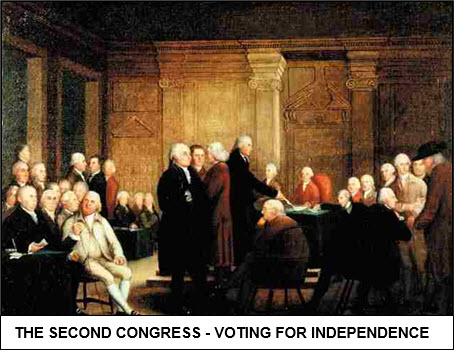 xxxxxAs we have seen, the First Continental Congress was called in September 1774, following on from the harsh measures (the “Intolerable Acts”) imposed after the so-
xxxxxAs we have seen, the First Continental Congress was called in September 1774, following on from the harsh measures (the “Intolerable Acts”) imposed after the so-
xxxxxEven so, when the Second Continental Congress was held in Philadelphia in May 1775, some eight months later, the majority of the leaders were still hoping for a reconciliation. All this changed, however, when news arrived of the armed clashes at the Battles of Lexington and Concord the previous month. The shots fired at Concord were not likely to have been heard “round the world” at this early stage, but they were certainly heard loud and clear in Philadelphia. Though a further appeal was made directly to the British people, Congress commissioned General George Washington to raise an army, justifying its action by its Declaration of the Causes and Necessity of Taking Up Arms. In the August George III responded by declaring a state of “rebellion and sedition”, and hiring 20,000 Hessian (German) soldiers. But even at this late stage many regarded the conflict as a civil war. There was little open talk of independence as yet.
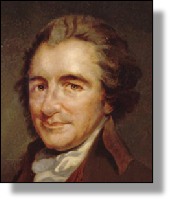
xxxxxIn the New Year, however, all this changed. The political as well as the military line was drawn and came into focus. In January the Anglo-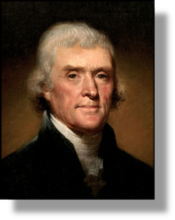 heory.
heory.
xxxxxA committee, which included the delegates Thomas Jefferson, Benjamin Franklin and John Adams, was appointed to produce the declaration, but Jefferson (illustrated), a political theorist, was assigned the task of preparing the draft. He willingly did so, later declaring that he used “neither book nor pamphlet” in the writing of it, and that he intended that it should be “an expression of the American mind”. It was revised only slightly by Benjamin Franklin and John Adams, but Congress made a number of alterations, including the deletion of a clause condemning the slave trade. The Declaration was made public on the 4th July 1776.
xxxxxThe document is best remembered today for a statement in the opening passage, the import of which was destined to have a profound influence on political thought from the French Revolution onwards. It leant heavily upon the writings of the English philosopher John Locke, who held that all government was to be founded on consent, designed only to protect the inherent rights of its people.
xxxxxWe hold these truths to be self-
xxxxxendowed by their Creator with certain unalienable Rights, that among these are Life,
xxxxxLiberty, and the pursuit of Happiness. That to secure these rights, Governments are
xxxxxinstituted among Men, deriving their just powers from the consent of the governed.
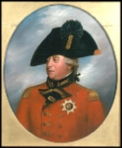
xxxxxBut the declaration was primarily designed to win over public opinion, not only at home, but also abroad -
xxxxxThe history of the British King of Great Britain is one of repeated injuries and usurpations,
xxxxxall having in direct object the establishment of an absolute Tyranny over these States….
xxxxxIn every stage of these oppressions We have Petitioned for Redress in the most humble
xxxxxof terms: Our repeated Petitions have been answered only by repeated injury. A Prince,
xxxxxwhose character is thus marked by every act which may define a Tyrant, is unfit to be the
xxxxxruler of a free people....
xxxxxWe therefore, the Representatives of the United States of America ... solemnly publish and
xxxxxdeclare, That these United Colonies are ... absolved from all Allegiance to the British crown....
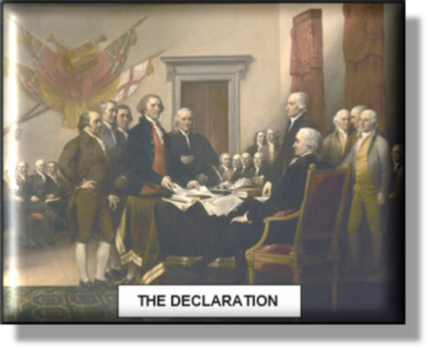 xxxxxBut, in fact, these “United Colonies” were far from united. Indeed, the actual task of providing a constitution for a new nation of thirteen disparate “colonies” proved difficult in the extreme. Suspicion and jealousy still existed between the states themselves, and, at the same time, each one was wary of an imposed central authority. Thus whilst the Declaration of Independence could be set down on parchment, and its fine passages admired and applauded, there was much to fear. As Benjamin Franklin was heard to mutter, “Gentleman, we must all hang together now, or we shall assuredly all hang separately.”
xxxxxBut, in fact, these “United Colonies” were far from united. Indeed, the actual task of providing a constitution for a new nation of thirteen disparate “colonies” proved difficult in the extreme. Suspicion and jealousy still existed between the states themselves, and, at the same time, each one was wary of an imposed central authority. Thus whilst the Declaration of Independence could be set down on parchment, and its fine passages admired and applauded, there was much to fear. As Benjamin Franklin was heard to mutter, “Gentleman, we must all hang together now, or we shall assuredly all hang separately.”
xxxxxIn fact a national constitution drawn up via the Article of the Confederation was not completed until 1777, and not ratified by all the states until 1781. And even then, these Articles formed a government with but partial jurisdiction, just giving Congress sufficient legal authority -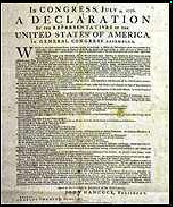 again. The bricks of a new nation were in place, but, as of yet, there was no cement with which to bind them together.
again. The bricks of a new nation were in place, but, as of yet, there was no cement with which to bind them together.
xxxxxIncidentally, after some years the parchment on which the Declaration of Independence was written began to deteriorate, and the text began to fade. The document is now sealed in a glass and bronze case filled with inert helium gas, and since 1952 has been housed in the National Archives exhibition hall in Washington D.C. ……
xxxxx...... The painting above showing the signing of the Declaration is by John Trumbull (1756-
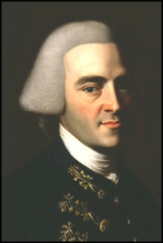
xxxxx...... AsxPresident of the Continental Congress, John Hancock (1737-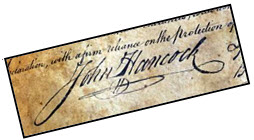 signed in a bold, flamboyant hand so that, he declared, the British ministry could read his name without spectacles and double their reward! From then on his name became a colloquial term for a signature in the United States.
signed in a bold, flamboyant hand so that, he declared, the British ministry could read his name without spectacles and double their reward! From then on his name became a colloquial term for a signature in the United States.
Acknowledgements
Voting: by the American portrait painter Edward Savage (1761-
G3a-


